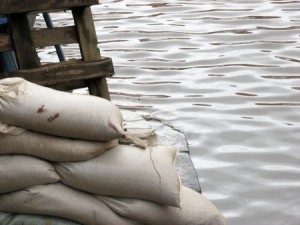3 flood-control projects to be completed in 2014, says DPWH

Three major flood control projects are expected to be completed this year– two in July, and a third in December, according to Department of Public Works and Highways Secretary Rogelio Singson.
But even with this infrastructure improvements, Singson said local and national government officials must do their part to improve non-structural measures to mitigate the effects of flooding, including strengthening the flood information and warning system, and relocating squatters whose shanties have clogged waterways.
These non-structural measures play a significant role in helping communities cope with flooding, which would never be gone from Metro Manila considering its geography and topography, where many of its areas lie below sea level, according to Metro Manila Development Chair Francis Tolentino.
“Metro Manila can never be flood free but we can be resilient. Part of being resilient is preparation,” Tolentino said.
Singson and Tolentino took part on Thursday in the flood control summit at the House of Representatives, which was organized by the Metro Manila Development Committee.
One of the two projects slated to be completed in July is the P1.5 billion Valenzuela-Obando-Meycauayan project, which consists of the construction of a flood control wall along the Meycauayan River in Valenzuela City and Obando, Bulacan; the desilting of the Meycauayan River; and the installation of submersible pumps in Valenzuela City.
The second is the P600 million Kamanava Project that consists of the drainage rehabilitation of Catmon Creek, the rehabilitation of the riverwall along the Malaban-Tullahan River, and the construction of pumping stations and floodgates in the area.
The Caloocan-Malabon-Navotas-Valenzuela area in Northern Metro Manila is flood-prone. It sits below sea level, so that waters rise in the streets even if there is little or no rain.
A third project to be completed by the end of the year is expected to reduce floods in Manila, including the regularly submerged areas near the University of Sto. Tomas.
The P479 million Blumentritt Interceptor Catchment Area is a 3.3 kilometer long and two-meter-deep culvert that runs all the way to Tondo. It will drain water from Quezon City that goes to the Sampaloc area in Manila and drain it toward Manila Bay.
But Singson said that the clearing of informal settlers along key waterways in Metro Manila would be critical to the success of these flood control projects.
According to him, some 19,440 families need to be relocated from major waterways in order to restore and improve the carrying capacity of the rivers.
For instance, if the waterways remain blocked, the Blumentritt interceptor would be of little help because the water would not be able to flow toward Manila Bay.
Interior and Local Government Secretary Mar Roxas, who also attended the summit, said his department has been focusing on relocating the settlers in the priority waterways.
Roxas said the settlers have the option to be relocated near site or onsite, so that they would not have to move far from the area where they have been working or where their children have been going to school.
Under this option, the government would help them form an association that would buy the property for their relocation with the government’s help and for the construction of medium-rise buildings as their new homes.
One such project has been ongoing in Caloocan, where the city government bought the land and the national government has funded the construction of the buildings for some 3,000 families, he said.
For those relocated to farther areas, Roxas said the National Housing Authority would provide them with free shuttle buses to bring them to areas of their work. At the same time, the local government units of their relocation sites have been asked to help find work for these settlers in the same locale.
Meanwhile, Singson also advised LGUs to get in touch with the weather bureau and have a briefing about its Project Noah, as it could give communities warnings about floods six hours before these could take place.
He said the weather bureau could use technology to predict how high flood waters would rise in certain communities, depending on the amount of rainfall. With this information, LGUs could provide residents with information and warning.
At the same time, LGUs must also work on installing a warning system and identify evacuation centers that residents could run to in case of an emergency, Singson said.